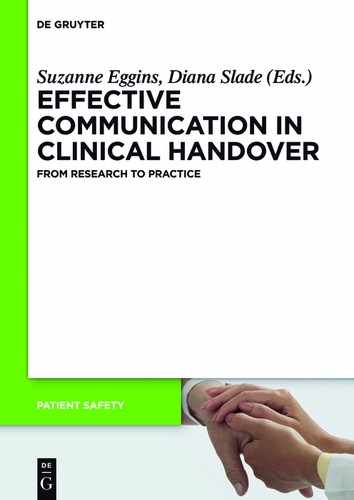5Resource: transferring patient information to the emergency department medical team during clinical handover
Marian Lee and Jeannette McGregor
In this chapter we draw together the material reviewed in chapters 3 and 4 to present a practical, step-by-step guide to the kinds of communication strategies that will assist doctors to gather information from patients in a systematic and logical way during clinical handover and will also make it easier for all emergency department medical team members and patients to participate in the process. In addition, the communication strategies we present here will support the transfer of all relevant information during clinical handover to those clinicians who are responsible for the next stage in the care process. This is crucial to maintaining patient safety because inadequate or lost information, or information that is not passed on to the people who need to know, can result in adverse outcomes for patients. In Tab. 5.1 below, we show the information categories that are most frequently used by doctors during clinical handover. The information categories are presented in the order that they most often appear during clinical handover.
Tab. 5.1: Categories of patient information to be transferred during emergency department clinical handovers
Categories of patient information that needs to be transferred during emergency department clinical handover
Patient profile: name, age (DOB), gender
Patient’s reason for being in the emergency department: the presenting problem(s) and particular information that individualizes each patient’s case
The time course of the symptoms of the illness, including what the patient or the general practitioner has done to make it better
Medical background that is relevant to the patient’s current problem
Medications, highlighting those that are relevant to the current problem
Allergies
Relevant social history
Examination findings, listing the most important positive and negative findings, ensuring vital signs are noted, including the level of pain in the form of a score where relevant.
Investigations required and/or findings that are relevant to the current problem
Management, composed of the following: treatment and the most appropriate place for the patient to continue to receive treatment (various options are available but the main decision is between whether the patient requires admission to a hospital ward or can be treated by a general practitioner in the community).
5.1How to transfer patient information to the emergency department medical team during clinical handover
We present Tab. 5.2 as a guide that will assist junior doctors to transfer patient information to the emergency department team during clinical handover. During this process, doctors present a synthesized version of the information gathered from the patient at the bedside during the initial assessment and stabilization stage and during any initial management of the patient’s presenting problem in the emergency department. We recommend that junior doctors follow the same steps as those in the tables below.
Tab. 5.2: How to communicate with team members when transferring information during clinical handover

5.2Establishing and building a positive relationship with patients and with emergency department team members during clinical handover
It is important for doctors to build relationships with patients and with emergency department team members during a clinical handover. A positive relationship with patients promotes their involvement in their own care process. A positive relationship encourages patients and other team members to take part in collaborative information building and decision-making during clinical handover. Table 5.3 outlines strategies for achieving a positive relationship.
Tab. 5.3: Ways to establish and develop a positive relationship with patients and with emergency department team members during clinical handover
| Ways to establish and build relationships with patients and team members during clinical handover | Tips to improve your communication | Examples |
| 1. Greet the patient and explain that you are going to do a handover. | Keep patients informed about what is happening to them. Many patients are not familiar with the way the emergency department works and may feel anxious or uncomfortable about being there. Patients have a right to be treated with respect and sensitivity, even in the crowded and chaotic context of the emergency department. | Good morning, Mrs Jabri. We’re just going to hand over your care to the new team. |
| 2. Manage the context by focusing on the needs of listeners. | Stand as close to other members of the emergency department team as the limited space allows. Make sure that you have eye contact with other team members to facilitate non-verbal communication. Also make sure that other team members and the patient can hear you above the ongoing noise of the emergency department. Speak clearly and at a reasonable pace. Emphasize key words. Be prepared to repeat words if necessary. | Can everyone hear me? OK. So the patient arrived at the emergency department at 7.30 this morning. She was brought in by her son who is also her carer. She experienced fever and rigors late last night but settled and went to sleep. However, she had the shakes when she went to the toilet this morning. She has no other urinary symptoms. |
| 3. Address both patients and fellow team members by name. | Show respect for both patients and your colleagues by using their names whenever possible. | Can you chase the results of the bloods, Dr Lin? |
| 4. Support an ‘opportunity to speak’ approach so that the patient and other team members are confident that their contributions to the clinical handover are welcome. | Respond positively to questions or clarifications sought by patients or colleagues. | Sorry. What was that, Mrs Jabri? What’s that, Leo? Was her urine clear? Yes, it was clear. |
| 5. Acknowledge the patient before the team moves on to the next clinical handover. | Thank the patient for his/her attention or contributions to the clinical handover process and close the conversation. | Thanks, Mrs Jabri. See you later. |



